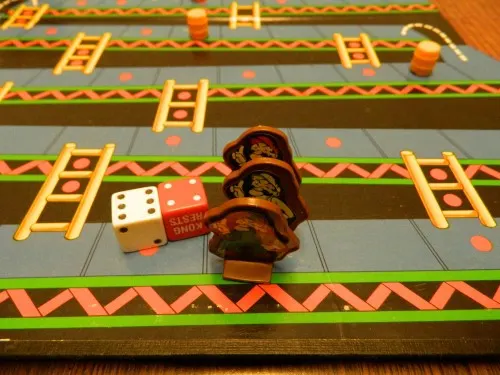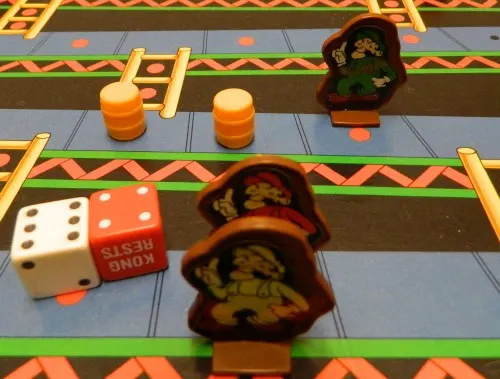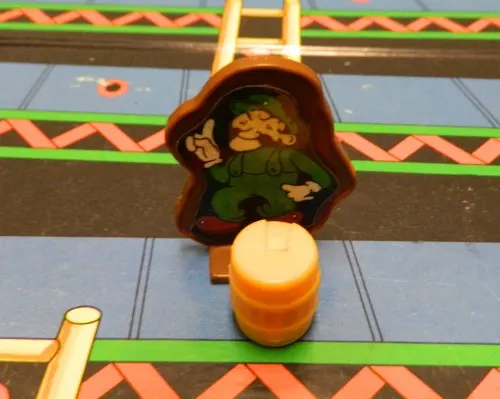How to Play
Objective
To acquire the most points before someone reaches the top of the game board.
Setup
Assemble the Donkey Kong piece, place six barrels inside, and place it on the correct space on the game board. Place the other six barrels on the black dots on the game board (one per space). All of the fireball tokens are placed at the bottom of the game board by the oil can. Each player chooses a Mario token and places it on the start space. Each player is dealt three cards face up and the rest of the cards form the draw deck. All of the players roll the white die to determine who goes first.
Player Movement
To begin a player’s turn they roll both dice. The white dice will determine the player’s movement while the red die will impact the movement of the obstacles (see below). The player must use the entirety of the number rolled. When moving a player’s pawn they can move in any direction but they can only move in one direction (can’t enter the same space twice on the same turn).

The current player has rolled a six on the white die and a four on the red die. All the obstacles will move four space while the player’s pawn will move six spaces.
Two players may not occupy the same space. If a player lands on an already occupied space, they move their pawn to the next available space. To move from one girder to another, players must use the ladders. If a player lands on a space with a red dot (by exact count), that player gets to draw an additional card and place it face up in front of them.

The green player has landed on a red dot space. The green player gets to draw a card and place it face up in front of themselves.
Obstacle Movement
After the player moves, all of the obstacles on the board will move. Starting with the fireballs, all fireballs on the game board move up the game board the number rolled on the red die. A fireball doesn’t enter the game board until a barrel reaches the bottom of the game board. After all of the fireballs have moved, the barrels move down the game board. Finally a new barrel is added to the game board by Donkey Kong at the top of the board.
If a “Donkey Kong Rests” is rolled, the obstacle step is skipped so no obstacles move and a barrel is not added to the board.
If an obstacle lands by exact count on a ladder space, it will travel up or down the ladder (barrels down, fireballs up). If a Mario pawn is on the ladder, the Mario pawn will get hit by the fireball requiring the player to play a card. A barrel will not roll down a ladder though if a Mario pawn is currently on the ladder.

After the barrels have moved, two of the barrels sit at the top of a ladder. The barrel on the right side will slide down the ladder. Since there is a player on the other ladder, the left barrel will not slide down the ladder.
When an obstacle reaches the edge of a girder, it will travel up/down following the white arrows and will continue moving until the whole die’s movement has been used.
When a barrel reaches the oil barrel at the bottom of the game board, it is turned into a fireball and will start moving up the game board. When the fireball reaches the top space on the game board it is removed from the game board.
If a barrel lands on a space occupied by another barrel, the barrel currently being moved will be moved to the next available space. If a fireball shares a space with a barrel, the barrel is destroyed. If a fireball lands on another fireball, the current fireball will move to the next available space.
Player/Obstacle Collisions
When a player and an obstacle occupy the same space (even if the player or obstacle still have spaces left to move), the player needs to use one of their cards to avoid the obstacle. To play a card a player must flip over a face up card which will score them the corresponding number of points at the end of the game. Cards come in two different varieties:
- Jump: Your character jumps over the obstacle. You receive the corresponding number of points but the barrel/fireball stays on the game board. If the obstacle lands on the player’s space by exact count and the player played a jump card, the obstacle will move forward one space.
- Hammer: Your character destroys the obstacle. The piece is returned to its’ proper space on the game board and the player gets the corresponding number of points.

A barrel has entered the same space as the green player. The green player has two jump and one hammer card face up in front of them. If the player chooses to use the hammer card it will destroy the barrel. If they use one of the jump cards, the barrel will move to the next spot on the game board.
If you have cards face up in front of you, you can avoid any object and you will receive some points in the process. If you don’t have any face up cards to play though, you will lose one of the cards you turned face down. This means you will lose some of the points that you had already earned. What is done with the card is dependent on whose turn it is when you can’t play the card.
- Your Own Turn: You randomly select one of your face down cards and return it to the bottom of the draw deck.
- On Opponent’s Turn: The opponent whose turn it is gets to take one of your face down cards at random. This card will be placed face up in front of them. If you only have no cards in front of you, the opponent gets to take a card from the draw deck.

The green player occupies the same space as a barrel. Since the green player has no face up cards in front of them they must randomly discard one of their face down cards. If this occurred on another player’s turn, that player gets to take the card that was discarded.
End of Game
Players continue moving up the game board trying to collect points from playing cards. The game ends when one player reaches the top of the game board. This player receives 500 bonus points. Every player counts up just the points of their face down cards (plus the 500 bonus points for the first finisher). Whoever has the most points wins the game.

The green player is the first player to reach the top of the game board. The green player will receive 500 bonus points.
Review
For the very few of you who don’t know already, Donkey Kong was an arcade game created in 1981 where you played as “Jump Man” (who would later become Mario) who needed to climb a set of girders to try and rescue Pauline from Donkey Kong. While Mario was trying to save Pauline, Donkey Kong would throw barrels at Mario and fireballs would become obstacles that Mario would have to overcome.
Back in the 1980’s Milton Bradley decided to start making a line of board games based on some of the most popular arcade games. Milton Bradley ended up making quite a few of these games which include games based on Pac-Man, Ms. Pac-Man, Zelda, Centipede, and even Super Mario Bros. Unfortunately these games don’t have a reputation for being good board games with most being average at best. When I found the Donkey Kong game for around $1 (it was missing some pieces), I couldn’t pass it up since at worst it would be a nice old video game collectible. While the Donkey Kong board game is not terrible, it fails to be much more than a simple roll and move game.
Faithful to the Original
For an early 1980’s board game I have to give the creators some credit for actually putting some thought into the game. With the popularity of the arcade game, the game could have been slapped together and still made quite a bit of money. A lot of tie in games from that era were simple roll and move games with a weak theme pasted on in order to appeal to popular trends of the era. Publishers usually didn’t care if the game was even any good as long as it made money.
While I have not played the original Donkey Kong arcade game that much, I have to give the board game credit for doing a good job replicating the gameplay from the arcade game. Obviously the board game is quite a bit slower than the video game, but most of the elements of the game are present in the board game. Players need to jump over or smash barrels and fireballs in order to get points. Players need to strategically use the ladders in order to reach the top of the board. Obviously the game had to take some liberties in order to turn the game into a board game, but I really can’t think of much more that could have been changed or added to the game.
Missed Opportunities
While the board game does a good job imitating the video game, that unfortunately is not enough to actually make Donkey Kong a good board game.
The biggest problem with Donkey Kong is that it is just boring. While the mechanics that were added to match the theme add some unique ideas to the roll and move genre, none of them really make the game that much better than other roll and move games. You pretty much roll the dice and move your pawn the corresponding number of spaces. You have a choice in how you want to move your pawn but it is usually pretty obvious what the best option is so you really don’t have much of a choice. While Donkey Kong is better than quite a few of the simple roll and move games, it isn’t significantly better than any of them.
Outside of moving around the game board, you have to deal with the various obstacles. These mechanics could have made Donkey Kong an original game. Unfortunately these mechanics don’t add much to the game. You can choose whether to use a hammer or jump over the obstacles. You could use the jump to force another player to have to face the obstacle. This would work if the next player doesn’t have a card to defend themselves. The hammer could be used to destroy the obstacle so no other players could play a card and gain points. It usually doesn’t really matter which one you choose to use though since all of the players will usually have enough cards to face any obstacle that they end up encountering. Players will generally just play their highest valued card when they run into an obstacle in order to score more points.
On top of always having spare cards to use, it is usually quite easy to avoid obstacles if you have to. You can avoid all of the barrels by landing on ladder sections. Since a player can move in any direction, they could just keep moving away from all of the nearby obstacles. When you get close to the top of the board, most of the obstacles have either already been passed or been destroyed by the other players so there aren’t even that many obstacles that you have to avoid. I think only one player in the entire game that I played ran into a situation where they had no cards to play when they encountered an obstacle.
The biggest problem with the obstacles are that they are a pain to move. On most turns you will end up spending considerably more time moving the obstacles than actually playing the game. You need to be really methodical moving the obstacles or you will likely miss moving one of them or moving one of them incorrectly which will affect the game. The obstacles are an interesting idea but at times they don’t seem worth it due to all of the work that is required moving them on every turn.
A Strange Scoring System
While trying to stay consistent with the video game, the Donkey Kong board game creates a strange scoring system. Generally in board games you try to avoid danger in order to gain or avoid losing points. In Donkey Kong you actually have to do the opposite in order to stand a chance at winning the game. It is weird playing a game where you have to run directly into obstacles in order to score points. If you have face up cards in front of you, there is no reason not to run straight into obstacles in order to score points.
This scoring system could lead to an interesting scenario where a player that is behind in points may have to wait at the top of the board in order to face some more obstacles in order to score enough points to catch up. Generally the 500 bonus points for finishing first are enough to win but I could see a situation where a player needs to extend the game in order to score some more points.
My biggest problem with the scoring system is that it adds a lot of luck to the game. Players that keep drawing high valued cards have a huge advantage over players that draw lower valued cards. The point value of most of the cards are pretty similar but if one player keeps drawing 100 point cards while another draws 400 point cards, I can’t see the unlucky player ever winning the game.
Nice Components
While I can’t make comments on all of the components since the copy I picked up was missing a couple pieces, I would say that they are pretty good. For the most part the pieces are pretty typical of a 1980’s board game. You have your plastic playing pieces and your cardboard cards. I do like that the game actually included plastic fireball and barrel pieces since the game could have easily just included cardboard markers in order to indicate the different obstacles. While the Donkey Kong piece adds quite a bit to the theme of the game, the piece is totally pointless for gameplay purposes.
My biggest problem with the components is that the stickers don’t want to stay on the game pieces. My copy of the game was not in good shape but only the Donkey Kong sticker was still in place. I ended up having to tape all of the stickers onto the corresponding pieces in order to get them to stay in place.
Final Verdict
The Donkey Kong board game is an interesting idea. You can tell that the designers put in quite a bit of time actually trying to make an authentic board game experience based on the arcade game. The game does a good job implementing most of the mechanics from the video game into the board game. Unfortunately that is just not enough since the Donkey Kong board game for the most part plays like most other traditional boring roll and move games. The new mechanics add a little to the game but none of them are good enough to overcome the basic roll and move mechanic of the game.
This doesn’t mean that Donkey Kong is a terrible game. I would consider it to be in the better half of roll and move games. If you don’t like roll and move games you won’t like Donkey Kong. The game is interesting enough though that it should appeal to fans of the arcade game and people who like roll and move games.


Q*bert Board Game Review and Instructions | Geeky Hobbies
Sunday 15th of November 2015
[…] the actual arcade game. Most of these games are not considered to be very good as evidenced by Donkey Kong, Ms. Pac-Man, and the Pac-Man Card Game that we have reviewed here on Geeky Hobbies. Due to my […]